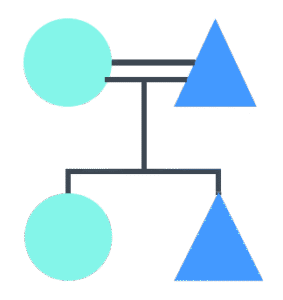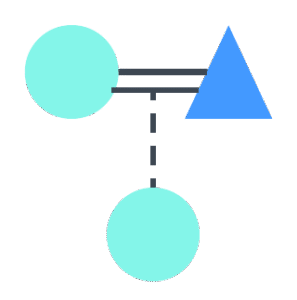Symbols Used In Kinship Diagram
The table below provides a clear guide to the symbols used in kinship diagrams, helping you better understand each relationship.
| Type | Symbol | Represents |
| People |  |
Female |
 |
Male | |
 |
Represents a person of non-binary gender. | |
 |
A line through the symbol symbolizes that the person is deceased. | |
| Marriage and cohabitation
|
 |
An equal sign between two individuals represents a marriage. |
 |
An approximately equal sign (≈) indicates a cohabiting couple who are not married. | |
 |
A similar sign ( ̴ ) denotes parents who are separated and not married. | |
 |
A not equal sign (≠) indicates that the marriage ended in divorce. | |
 |
If someone has been married twice, equal signs on both sides of the symbol represent each marriage, with the first spouse placed on the left. | |
 |
For more than two marriages, lines drawn below the symbols show connections between all spouses. | |
| Descent
|
 |
A solid line going straight down from the marriage or cohabitation symbol indicates a biological parent-child relationship. |
 |
A dotted line represents an adoptive parent-child connection. | |
 |
If the parents are unknown, a bar above the siblings’ symbols shows that they share a common origin. |
How to Make a Kinship Diagram (Step-by-Step Guide)
A kinship diagram is a simple way to show family relationships using symbols. However, you can follow these easy steps to create a kinship diagram of your own.
Step 1: Start with a Template
Use an online tool like Lucidchart or Creately to make things easier. These tools offer ready-made templates, so you don’t have to start from scratch. Just pick a layout and begin building your family diagram.
Step 2: Choose the Main Person (Ego)
Place the main person called Ego in the center of your diagram. Ego is the reference point for all other relationships. You can use a different color or style to make this person stand out.
Step 3: Gather Family Information
Talk to a family member who knows the family well. Ask about close relatives, their names, and how they’re connected. Write this down carefully to avoid any confusion later.
Step 4: Add Family Members Using Symbols
Use simple symbols:
- Circle (○) for a female
- Square (□) for a male
- Other symbols for non-binary or adoptive members
Drag and drop these shapes into your diagram. Label each one with names and other details if needed.
Step 5: Connect Family Members
Draw lines to show relationships:
- A horizontal line between two people means marriage or partnership
- A vertical line from parents to children shows descent
- Use a dotted line for adoptive relationships
- Use special signs like ≠ for divorce or ≈ for cohabiting couples
Place older generations at the top and younger ones at the bottom so it’s easy to read.
Step 6: Show Cultural Family Patterns (Optional)
If you want to include cultural rules of descent (like tracing family through the father’s or mother’s side), use different colors or styles to show this clearly. For example:
- Patrilineal = father’s side
- Matrilineal = mother’s side
- Bilateral = both sides
- Ambilineal = choice between sides
Step 7: Add Relationship Labels (Optional)
To make things clearer, you can label each person’s role in relation to Ego using short terms like:
- M = Mother
- F = Father
- B = Brother
- D = Daughter
- Z = Sister
Step 8: Customize and Finalize
Change colors, fonts, or line styles to make the diagram look clean and easy to follow. Add any important notes, like birthdates or other details.
Step 9: Save and Share
Once your diagram is ready, save it in your preferred format such as PDF, PNG, JPEG, or SVG. You can print it, present it, or share it with your family to get feedback or suggestions.
Popular Tools To Draw Kinship Diagrams
You can easily create a Kinship Diagram with the help of the tools mentioned below:
- Lucidchart
- draw.io
- Creately
Benefits Of Using Diagram
- It shows how people in a family are connected.
- Helps organize large or blended families clearly.
- Tracks ancestors and descendants easily.
- Helps genealogists, anthropologists, and historians study family structures.
- Makes it easy to focus on one person or relationship.
- Shows how different societies define family roles.
- Helps detect errors or gaps in family records.
Final Thoughts
A kinship diagram is a simple and effective way to map out family relationships. It uses easy-to-understand symbols to show connections like marriage, birth, adoption, and cultural family patterns. Whether you are a genealogist, anthropologist or simply interested in discovering your family history, this tool can assist you with organizing and visualizing even the most intricate family system. In addition, kinship diagrams provide a way for people to understand family relationships and identify gaps in records.
Confused Or Have Questions?
No worries, we’ve got you. Our experts can guide you with everything or answer all your doubts. All you need to do is contact us on our helpline number, which is the Family Tree Support number: +1-888-427-8070, or reach out through live chat support.
